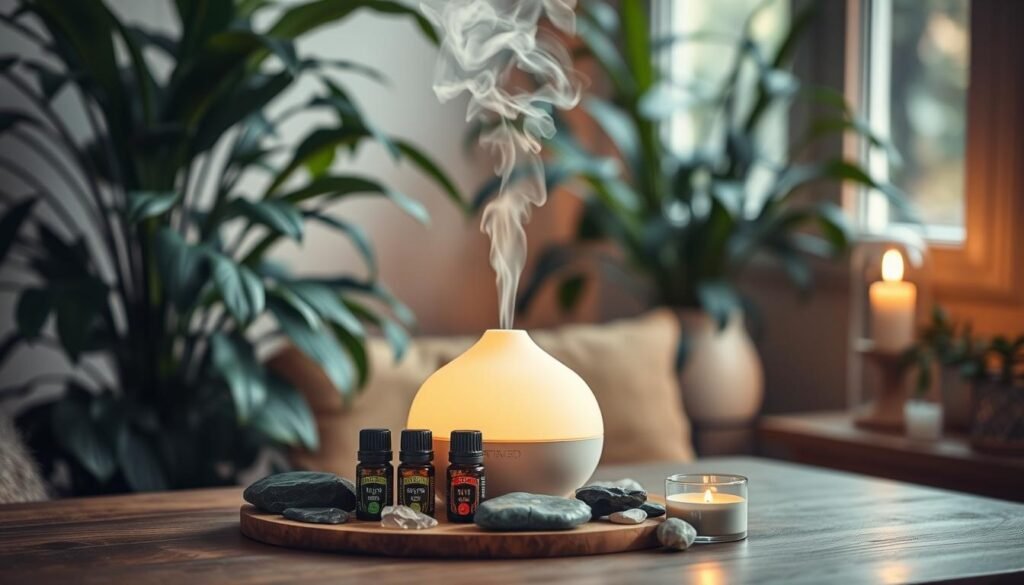Did you know that about 2-3% of people in the United States undergo panic disorder annually? This fact shows how common anxiety attacks are. They can reach their peak in just 10 minutes after starting. Knowing how to soothe yourself during an anxiety attack is key for many. This guide offers ways to ease anxiety. It talks about useful strategies like breathing exercises, being mindful, and caring for yourself.
Learning about what triggers your anxiety and how your body reacts is important. It helps you manage your emotions better and find calmness in tough times. This guide talks about different ways to relieve anxiety. It aims to help those dealing with anxiety feel more confident and peaceful.
Key Takeaways
- Panic attacks can peak within 10 minutes, making timely intervention crucial.
- Recognizing personal triggers, such as crowded places or public speaking, can aid in prevention.
- Utilizing breathing techniques can provide immediate relief during panic episodes.
- Mental health professionals recommend cognitive behavioral therapy (CBT) as an effective treatment method.
- Engaging in light exercises, like walking, enhances mood by releasing endorphins.
- Using essential oils, such as lavender, may help reduce anxiety symptoms naturally.
- Social support from friends or family can create a sense of control during anxiety attacks.
Understanding Anxiety Attacks
Understanding anxiety attacks is vital. They can interrupt daily life. They may happen without warning or from stress. Knowing what an anxiety attack is, and its symptoms, helps. This knowledge allows for better handling of these hard times.
What is an Anxiety Attack?
Anxiety attacks, also known as panic attacks, bring intense fear quickly. They often reach their worst within ten minutes but don’t last more than thirty minutes. Many will experience an anxiety attack at some point. For some, frequent attacks suggest a panic disorder. The DSM-5-TR lists this disorder, including unexpected and expected types of panic attacks.
Common Symptoms of Panic Attacks
It’s key to know the symptoms of panic attacks. Symptoms include:
- Heart palpitations
- Chest pain
- Shortness of breath
- Excessive sweating
- Trembling or shaking
- Nausea or dizziness
- Fear of losing control or dying
These symptoms are both physical and emotional. They feel overwhelming. Understanding them gives power to those dealing with anxiety attacks. Deep breathing and mindfulness are helpful. For more tips, consider this guide on coping skills.
Recognizing the Signs of an Oncoming Attack
Knowing the signs of anxiety attacks is key to control and lessen their impact. By spotting the early signs, people can get ready to deal with them better. Knowing what physical symptoms and environments trigger anxiety helps greatly.
Physical and Emotional Symptoms
Physical symptoms of anxiety are strong and include:
- Accelerated or pounding heartbeat
- Shortness of breath
- Trembling or shaking
- Chest pain or tightness
- Sweating
- Feelings of impending doom or danger
Emotions might turn into intense fear or feeling out of control. Spotting these signs early lets people manage them sooner. This action can make attacks less severe.
Environmental Triggers to Watch Out For
Certain places or situations act as triggers, often worsened by stresses like:
- Crowded or noisy places
- High-pressure work environments
- Strained social interactions
It’s critical to be aware of these triggers, especially for anyone with anxiety history. Steering clear of or getting ready for these situations can help avoid panic attacks.
How to Calm Down from an Anxiety Attack
Feeling overwhelmed by anxiety happens to many people. It’s important to remind yourself that panic attacks don’t last forever. Learning different ways to ease anxiety can really help. Knowing how to soothe yourself during an anxiety attack can bring relief and a feeling of control.
Remember That It Will Pass
Anxiety attacks usually don’t last more than 30 minutes. However, some folks may feel them for longer. In those times, your mind can seem all over the place. Remembering that the anxiety will pass can help you relax.
Utilizing Grounding Techniques
Grounding techniques help you stay present. These techniques include:
- Breathing deeply and slowly to calm the heart rate.
- Identifying five things that can be seen, four that can be felt, three that can be heard, two that can be smelled, and one that can be tasted to enhance awareness of the surroundings.
- Using objects nearby, like touching a surface or holding a comforting item.
Using these techniques regularly can help you manage anxiety better. Visualization and positive affirmations can also help during an attack. Applying different strategies can strengthen your feeling of calm during anxiety’s chaos.
| Technique | Description | Benefits |
|---|---|---|
| Deep Breathing | Focus on inhaling slowly and exhaling fully. | Reduces heart rate and lowers anxiety levels. |
| 5-4-3-2-1 Method | Identify five sights, four feelings, three sounds, two smells, and one taste. | Enhances awareness and pulls attention from stressors. |
| Object Focus | Concentrate on an object, engaging the senses. | Provides an anchor point during overwhelming feelings. |
Breathing Exercises for Anxiety
Breathing exercises are key in handling anxiety, especially during a tough moment. Deep breathing offers quick relief and helps you relax. There are many specific methods designed to help people take control of their breathing and ease their minds.
Deep Breathing Techniques Explained
The 4-7-8 technique by Dr. Andrew Weil is very effective. It involves breathing in through the nose for 4 seconds, holding it for 7 seconds, and exhaling for 8 seconds through the mouth. This method helps calm the body, slow down the heart rate, and bring a sense of peace.
Lion’s breath involves breathing in deeply through the nose and exhaling strongly through the mouth. This helps release tension and boosts confidence. Alternate nostril breathing helps even out your breath and lower stress. Adding these techniques to daily routines can greatly help with managing your breathing.
Benefits of Controlled Breathing
Breathing exercises offer more than just quick relief from anxiety. A study in 2018 found that slow, deep breathing can lessen depression and anxiety symptoms. Methods like resonance breathing, done for about 10 minutes, can stop anxiety attacks and help you stay calm. They also help reduce blood pressure, which is useful during stressful times.
These exercises are very helpful for people with trauma-related issues, like PTSD. Focusing on controlled breathing helps reconnect with oneself, which helps with stress management. Making these exercises part of your daily life can boost your ability to deal with anxiety and improve mental health.

Mindfulness for Panic Attacks
Mindfulness techniques help a lot with panic attacks, especially when stressed. A good approach is the 5-4-3-2-1 technique. It uses our senses to focus our mind on the now. This can make the big feelings of anxiety smaller and make us more aware of our surroundings.
The 5-4-3-2-1 Method Explained
The 5-4-3-2-1 method has us find:
- 5 things you can see
- 4 things you can touch
- 3 things you can hear
- 2 things you can smell
- 1 thing you can taste
This way of focusing can take our mind off worries and help us feel calm. Studies show using mindfulness this way can lower our anxiety. That makes it a big help for people facing these challenges.
Visualizing a Safe Place
Visualizing a safe place is another mindfulness method. When we picture a calming place, we can feel safer. It could be a beach, a comfy room, or a peaceful forest. Thinking about this place can calm our minds during a panic attack.
Using this technique often can make us less anxious over time. Research finds that people feel better after a few tries.
Adding these practices to our day can make our mental health better. Mindfulness helps us handle panic attacks and understand our thoughts and feelings better. For tips on making a calming space for yourself, check out this useful article.
Calming Anxiety Symptoms with Essential Oils
Essential oils are a natural way to calm anxiety symptoms. Many people feel better using oils like lavender. Studies show lavender oil helps reduce anxiety, making it popular for wellness. Oils such as chamomile and bergamot also offer benefits for easing anxiety.
How Lavender and Other Oils Can Help
Lavender oil is proven to lower anxiety levels. Some studies suggest it’s as good as some anxiety meds. Chamomile and bergamot oils also help with anxiety. For example:
- Chamomile oil: Inhaling it can lower stress significantly.
- Bergamot oil: Used in aromatherapy, it eases anxiety in stressed people.
- Ylang-ylang oil: It calms, reducing stress-related high blood pressure and heart rate.
Methods to Use Essential Oils Effectively
To use essential oils well, you must know how to apply them. Inhaling them is a common method. This quickly sends the scents to your brain, improving mood and reducing stress. A few recommended ways include:
| Essential Oil | Application Method | Benefits |
|---|---|---|
| Lavender | Inhalation / Diffusion | Reduces anxiety and promotes relaxation |
| Chamomile | Inhalation | Diminishes stress levels |
| Bergamot | Aromatherapy | Alleviates anxiety in stressed individuals |
| Ylang-Ylang | Topical / Inhalation | Helps lower blood pressure and heart rate |
Always dilute essential oils and talk to a healthcare pro before use. They are not FDA regulated. Doing a patch test is important to avoid allergic reactions. By using these oils mindfully, you can make them a helpful part of your anxiety relief routine. To learn more about essential oils for anxiety, see this helpful article.

Self-Care During Anxiety Episodes
It’s crucial to care for yourself when feeling anxious. Having a peaceful spot for anxiety helps focus during tough times. A calm place aids in calming your mind, relaxing, and balancing emotions.
Importance of Finding a Peaceful Spot
Creating a calm space is key when things get hard. This spot could be anywhere you feel relaxed, like a cozy chair or a quiet spot outdoors. Make sure it’s a no-distraction zone, perfect for breathing deeply or practicing mindfulness.
Engaging in Light Exercise
Light exercise for anxiety relief can lessen anxiety. Try walking or gentle stretching to boost your mood and health. Doing moderate exercise for 2½ hours a week can improve your mental health.
Combining relaxation and light exercises builds resilience. A regular self-care routine helps manage emotions for a balanced life. Check out NHS Mental Health Services for more tips on coping.
Coping Strategies for Anxiety Attacks
Addressing anxiety attacks can be done through effective coping strategies. Using mantras for anxiety is a valuable technique. It helps individuals focus and find strength during a panic. By repeating comforting phrases, they can create calm and resilience amidst overwhelming emotions.
Using Mantras for Focus and Strength
Mantras offer significant emotional support during panic moments. Simple affirmations remind people of their inner strength. They help individuals navigate through tough experiences. Phrases like “I am safe,” “This will pass,” or “I can breathe” can lower anxiety. They promote peace.
Repeating these mantras during a panic attack connects the mind and body. This connection encourages relaxation.

Incorporating mantras has benefits, especially with deep breathing methods. Studies show these strategies, including mantras, improve emotional well-being. Focusing on specific phrases counters negative thoughts. It creates a calm mental space. For those experiencing panic attacks, using mantras becomes a simple, powerful routine.
For more techniques on managing anxiety, check this resource. It offers insight into strategies that build emotional resilience.
Talking to a Trusted Friend
Reaching out to trusted friends can really help when you’re feeling anxious. It makes you feel safe and understood. Talking about what you’re going through helps friends know how to be there for you.
This kind of communication is key in tough times. It lets you clearly say what you need and feel. This makes sure you get the right help when you’re stressed.
The Benefits of Social Support
Having a friend who gets it can be very comforting. Talking about your struggles decreases feeling alone. They can give you the support you need during panic times.
This connection is not just for now. It builds emotional strength for the future. It helps you handle stress better every time.
What to Share for Effective Support
Telling friends about your anxiety with details helps a lot. You might share:
- Symptoms experienced: Like a fast heartbeat or feeling dizzy. This helps friends understand better.
- Your preferences: Whether you like them just being there or doing something calming together.
- Panic triggers: Knowing what sets off your anxiety helps them protect you better.
Clear communication leads to better understanding. It’s a good idea to practice talking about your needs. This makes your conversations more helpful.
Consulting a Mental Health Professional
When you’re facing anxiety and panic attacks, talking to a therapist is key. Knowing when help is needed for anxiety is important. Many people see signs that they need help from a pro. Spotting these signs means you can start getting better.
When to Seek Help
If any of these things happen to you, it might be time to see a mental health pro:
- Frequent panic attacks that mess with your day
- Strong anxiety that won’t go away
- Physical symptoms that make daily tasks hard
- Struggling to handle stress or triggers
- Feeling hopeless or worthless
These signs show why it’s crucial to talk to a mental health expert. They can figure out what you need and suggest the best treatments.
Types of Therapy for Panic Attacks
Different therapies can help with panic attacks and anxiety. Cognitive Behavioral Therapy (CBT) is really effective. It helps you rethink and change your thoughts, reducing anxiety. Other methods include:
| Type of Therapy | Description |
|---|---|
| Cognitive Behavioral Therapy (CBT) | Changes negative thoughts to lower anxiety. |
| Mindfulness-Based Therapy | Uses mindfulness to handle and lessen anxiety. |
| Exposure Therapy | Slowly faces fears to reduce their effect. |
| Support Groups | Provides a space to share with others facing similar issues. |
Medications can also help with anxiety symptoms. Doctors might prescribe antidepressants, anti-anxiety drugs, or sedatives. Making changes in your lifestyle, practicing mindfulness, and learning coping strategies are also helpful. Getting help from pros not only makes you understand your anxiety better. It also gives you tools to look after your well-being.
Conclusion
Understanding panic attacks is crucial for managing anxiety. About 2.7% of U.S. adults face these attacks yearly. It’s key to know reliable ways for anxiety relief. Deep breathing, mindfulness, and self-care can really help calm an anxiety attack.
Using methods like muscle relaxation and fighting off negative thoughts can lessen symptoms. Also, getting help from professionals, friends, or groups can build a strong recovery base. Adding these techniques to your daily routine makes them work better when you really need them.
In summing up how to deal with panic, mixing self-care, expert advice, and ongoing practice of these methods improves life. By focusing on these steps, people can prepare to tackle their fears and grow stronger against panic attacks.